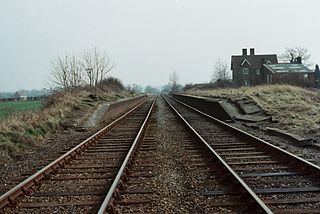
Verney Junction railway station was an isolated railway station at a four-way railway junction in Buckinghamshire, open from 1868 to 1968; a junction existed at the site without a station from 1851.
Granborough Road railway station was a station serving the village of Granborough, to the north of Quainton in Buckinghamshire, England.
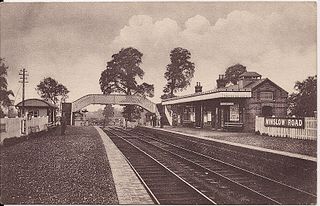
Winslow Road railway station served the village of East Claydon near Winslow to the north of Quainton in Buckinghamshire, England. It was the second station to serve the town after Winslow on the Varsity Line.

Claydon railway station is a former railway station on the 'Varsity Line', that served the village of Steeple Claydon in Buckinghamshire.
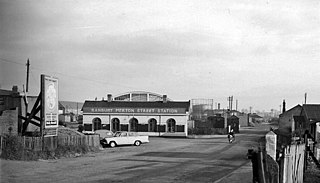
Banbury Merton Street was the first railway station to serve the Oxfordshire market town of Banbury in England. It opened in 1850 as the northern terminus of the Buckinghamshire Railway providing connections to Bletchley and Oxford and closing for passengers in 1961 and goods in 1966.
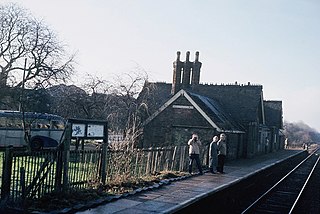
Winslow railway station refers to either one of two railway stations which historically served or is planned to serve, the town of Winslow in north Buckinghamshire, England. The original station (1850–1968) was on the former Varsity Line between Cambridge and Oxford. As of September 2022, construction of a new station nears completion and is scheduled to be served by East West Rail, as part of the plan to reinstate the Oxford–Cambridge service.
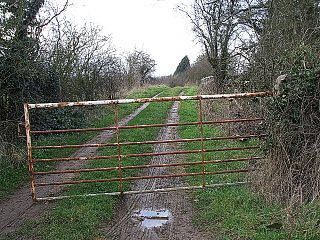
Radclive Halt was a railway station on the Banbury to Verney Junction Branch Line which served the village of Radclive in Buckinghamshire, England, from 1956 to 1961.
Water Stratford Halt was a railway station on the Banbury to Verney Junction Branch Line which served the village of Water Stratford in Buckinghamshire, England, from 1956 to 1961.
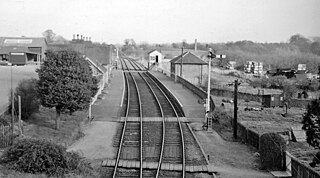
Brackley Town was a railway station which served the Northamptonshire town of Brackley in England. It opened in 1850 as part of the Buckinghamshire Railway's branch line to Verney Junction which provided connections to Banbury, Bletchley and Oxford and closed in 1963.

Padbury railway station served the village of Padbury in the English county of Buckinghamshire. It opened in 1878 as part of the Buckinghamshire Railway's branch line to Verney Junction which provided connections to Banbury, Bletchley and Oxford and closed in 1964.

Salcey Forest railway station was a short-lived railway station in England, on the Stratford-upon-Avon, Towcester and Midland Junction Railway which opened on 1 December 1892 near the Northamptonshire forest of the same name. The station was not situated near any settlement and only saw passenger services for four months, it being most likely an error of judgement by the railway company which had provided substantial station facilities in expectation of traffic which never came. Salcey Forest station eventually closed on 31 March 1893 and has an arguable claim, along with Stoke Bruerne, of having had the shortest passenger service ever provided at any British railway station. Goods facilities were withdrawn in 1952. Now it’s known as doggers lodge
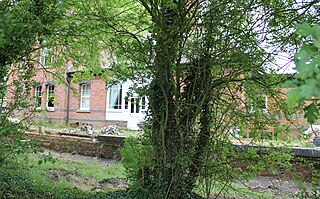
Stoke Bruern railway station was on the Stratford-upon-Avon, Towcester and Midland Junction Railway which opened on 1 December 1892 near the Northamptonshire village of Stoke Bruerne after which it was misnamed. Passenger services were withdrawn on 31 March 1893. It is arguable that Stoke Bruern along with Salcey Forest have a claim to have had the shortest passenger service of any British railway station. On the first service, it was reported that one person alighted at Salcey Forest, but no-one joined, whilst at Stoke Bruern, seven joined and one alighted. The service attracted no more than twenty passengers a week and the SMJ incurred a loss of £40. The station was situated in a sparsely populated area and only saw passenger services for four months, despite the railway company's optimism which saw substantial station facilities provided in the expectation of traffic which never came. The station remained open for goods until 1952.
Tiffield was a short-lived experimental railway station situated at the highest point of the Stratford-upon-Avon and Midland Junction Railway which opened in 1869 to serve the Northamptonshire village of Tiffield, only to close two years later.

Towcester was a railway station on the Stratford-upon-Avon and Midland Junction Railway which served the town of Towcester in Northamptonshire, England between 1866 and 1964.
Wappenham was a railway station on the Stratford-upon-Avon and Midland Junction Railway (SMJ) which served the Northamptonshire village of Wappenham between 1872 and 1951. Serving a relatively rural area, the station saw considerable goods traffic generated by local farming communities, but passenger traffic was low which ultimately led to its closure.

Helmdon Village railway station on the Stratford-upon-Avon and Midland Junction Railway (SMJ) served the Northamptonshire village of Helmdon between 1872 and 1951. It was one of two stations serving the lightly populated rural area, the other being Helmdon railway station on the Great Central Main Line, and its closure marked the beginning of the years of decline for the SMJ line.
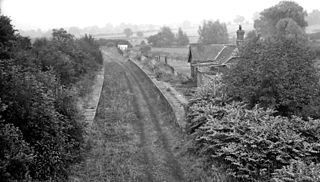
Blakesley was a railway station on the Stratford-upon-Avon and Midland Junction Railway (SMJ) which served the Northamptonshire village of Blakesley between 1873 and 1962. It was linked to nearby Blakesley Hall by a miniature railway which ran from a terminal adjacent to the station.

Morton Pinkney was a railway station on the Stratford-upon-Avon and Midland Junction Railway (SMJ) which served the Northamptonshire village of Moreton Pinkney between 1873 and 1952. It was situated not far from Sulgrave Manor, the ancestral home of George Washington's family.

Fulwell & Westbury was a railway station in Buckinghamshire that served the village of Westbury and the hamlet of Fulwell in neighbouring Oxfordshire, England. It opened in 1879 London & North Western Railway who had taken over the line from the Buckinghamshire Railway that year. The station consisted of one platform, a ticket office, and two waiting rooms. The station was closed for passengers in 1961 and completely in December 1963.
The Banbury to Verney Junction branch line was a railway branch line constructed by the Buckinghamshire Railway which connected the Oxfordshire market town of Banbury with the former Oxford/Cambridge Varsity line and the former Metropolitan Railway at Verney Junction, a distance of 21 miles 39 chains. Onward routes from there ran to the West Coast Main Line at Bletchley via Brackley and Buckingham and thence to Cambridge, or to Aylesbury for London.

















